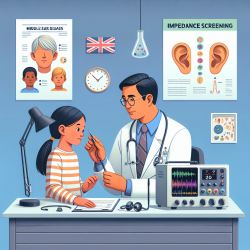Introduction
In the realm of speech-language pathology, understanding the genetic underpinnings of neurodegenerative disorders can significantly enhance therapeutic approaches. The recent study titled "De novo pathogenic variant in SETX causes a rapidly progressive neurodegenerative disorder of early childhood-onset with severe axonal polyneuropathy" sheds light on a rare genetic variant in the SETX gene, which has profound implications for early childhood development and therapy. This blog aims to explore the study's findings and discuss how practitioners can leverage this knowledge to improve outcomes for children.
Understanding the SETX Variant
The SETX gene encodes for senataxin, a protein with critical roles in transcriptional regulation and RNA processing. Pathogenic variants in SETX are known to cause two distinct neurological disorders: ataxia with oculomotor apraxia type 2 (AOA2) and amyotrophic lateral sclerosis type 4 (ALS4). The study identifies a de novo variant, c.23C?>?T (p.Thr8Met), in two unrelated patients, presenting with severe polyneuropathy and an early onset neurodegenerative disorder.
Research Methodology
The researchers employed Weighted Gene Co-expression Network Analysis (WGCNA) to identify disease-associated modules. By comparing ALS4 mouse models with confirmed ALS4 patient data, they derived an ALS4-specific transcriptional signature. This approach confirmed the pathogenic nature of the p.Thr8Met variant, expanding the clinical spectrum of SETX-related disorders.
Implications for Practitioners
For speech-language pathologists, understanding the genetic basis of disorders can enhance diagnostic accuracy and treatment planning. Here are some ways practitioners can implement the study's findings:
- Genetic Counseling: Encourage families to seek genetic counseling if a child presents with symptoms similar to those described in the study. Early identification of genetic variants can guide treatment and management.
- Interdisciplinary Collaboration: Work closely with neurologists and geneticists to develop comprehensive care plans that address both the neurological and communicative needs of the child.
- Tailored Interventions: Use the genetic information to tailor speech and language interventions, considering the specific neurological challenges faced by the child.
- Research and Advocacy: Advocate for further research into SETX-related disorders to develop targeted therapies and improve outcomes for affected children.
Encouraging Further Research
The study highlights the need for continued research into rare genetic disorders. Practitioners are encouraged to contribute to this growing body of knowledge by documenting clinical observations and outcomes. Collaboration with research institutions can provide valuable insights into the efficacy of therapeutic interventions.
Conclusion
The discovery of the SETX p.Thr8Met variant opens new avenues for understanding and treating neurodegenerative disorders in children. By integrating genetic insights into clinical practice, speech-language pathologists can enhance their ability to deliver personalized care and improve the quality of life for affected children.
To read the original research paper, please follow this link: De novo pathogenic variant in SETX causes a rapidly progressive neurodegenerative disorder of early childhood-onset with severe axonal polyneuropathy.










